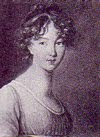

Young Knitter Asleep (1759)
Jean-Baptiste Greuze
(French, 1725-1805)
Oil on canvas, 68 x 58 cm
Huntington Library, Art Collections,
San Marino, California
Jean-Baptiste Greuze
(French, 1725-1805)
Oil on canvas, 68 x 58 cm
Huntington Library, Art Collections,
San Marino, California
I love this painting for many reasons: it is from the 18th century, the child is sweet, the colours are soft, and the knitting is intriguing. Once again, as in "A Serving Girl Knitting," the fourth needle is not visible although its presence is implied under her left hand wrist. There seems to be a considerable amount of knitting in her lap, too much for a stocking. Could it be a shirt, heaped on her lap and a sleeve, knit from the shoulder down, on the needles? Or is it, in fact, a pair of stockings, the upper part of the one on the needles on the (her) right side of her lap, and a finished one, for reference, perhaps, on the (her) left side, the thigh hem's thin edge hanging downwards at the extreme right? We also cannot see any strand of yarn. There is a partially round shaped white object in her basket. Is that the yarn for this knitting and the strand is hidden under between her basket arm and her lap? Since there is no yarn wrapped around her fingers, did she sit down, take out her knitting and close her eyes for few minutes, and then fall asleep before knitting a stitch? Or is she like many of the young girls' from this era, whose journals contain daily entries about knitting so many mandatory rounds of a stocking a day, bored with her knitting?
I would like to think it is a knitted shirt as I have been doing extensive research about that kind of garment in the 17th, 18th and 19th centuries for the past few years. The more I look at the painting, however, and given the limited repertoire of knitting at this time, the more the two stockings seem to take form. Are there any other opinions?
















